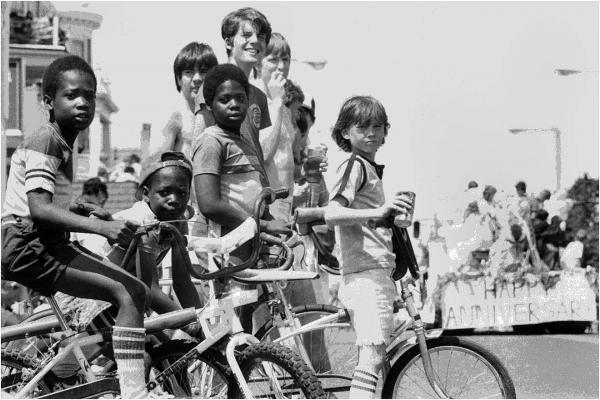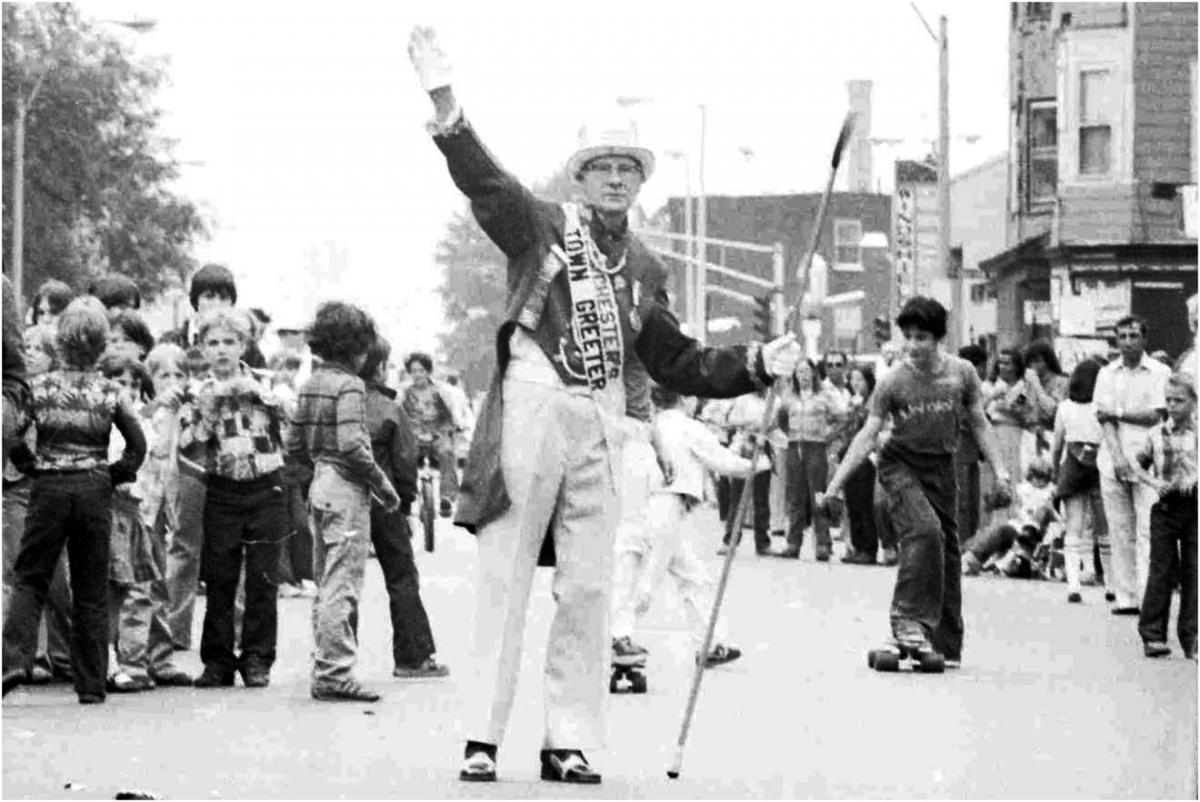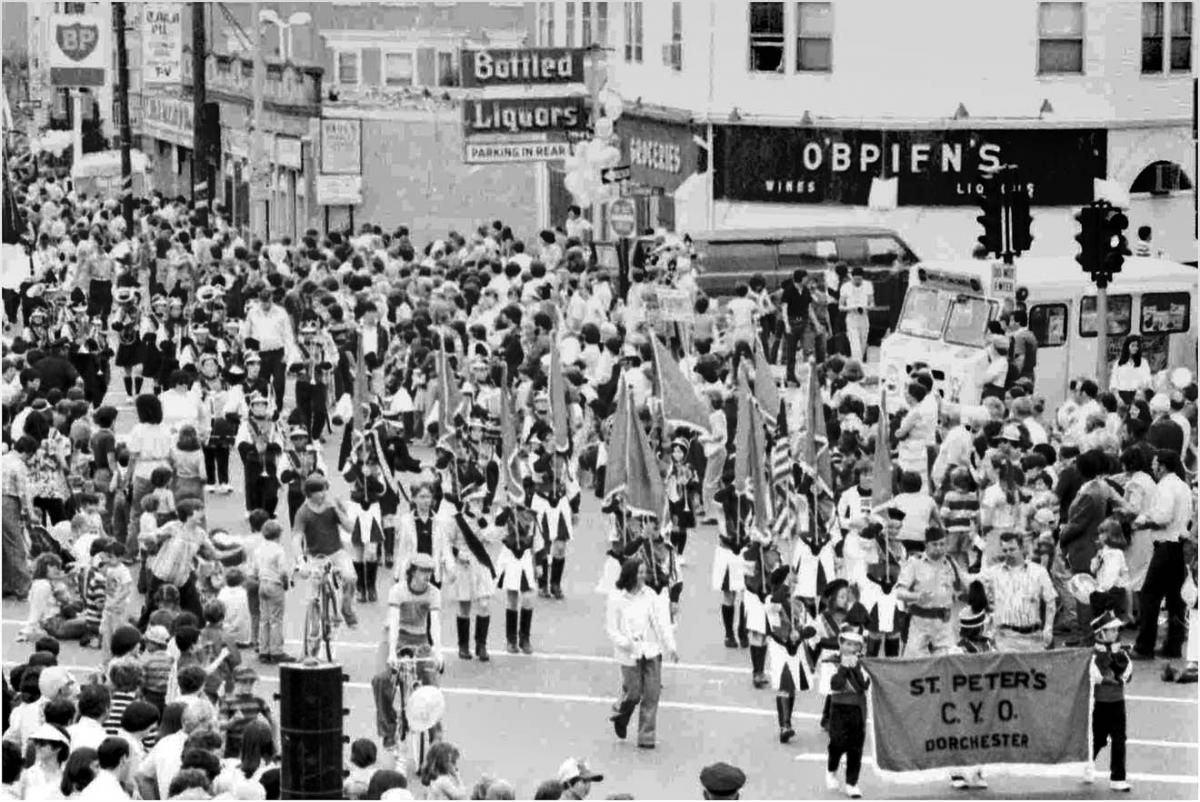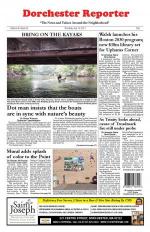May 30, 2019

A crowd of teens and kids watched the Dorchester Day Parade in 1979. Chris Lovett photo
The first observance of Dorchester Day, in June of 1904, took place under a tent on Savin Hill. A celebration of local history and pride, it was also meant to protect an urban wild with a panoramic view from a frenzy of new development.
But by the beginning of the 20th century, the fast pace of change in Dorchester was hard to ignore. Over the fifty years after its annexation to Boston, in 1870, Dorchester’s population would increase more than ten-fold. And, even by 1910, more than one-third of the growing population in all of Boston was made up of immigrants.
During this period, Dorchester, connected to the rest of Boston by public transportation and water and sewer lines, was filling up with multi-family housing. It was now easy to live in one part of the city and work in another. Too remote and spacious to be an extension of the Back Bay or the South End, but no longer a self-contained community, Dorchester had become the hybrid that would later seem oxymoronic—the “streetcar suburb.”
Despite all the growth, there were also signs of decline, or change of a different kind. As early as 1891, the Dorchester Antiquarian and Historical Society was down to only three members. In the same year, it would be succeeded by the lead organization behind the first Dorchester Day, the Dorchester Historical Society.
By 1910, even the mix of Boston’s new arrivals had changed, with the Irish being outnumbered by Jewish and Italian immigrants. In 1914, a Unitarian minister in Grove Hall noticed fewer people at church. A local newspaper, the Dorchester Beacon, listed properties changing hands, moving from families with names like Brooker, Hutchins and Greenwood to those with names like Weiner, O’Loughlin, and Mugardichian. And, at a “mass meeting,” the Fields Corner Women’s Temperance League rallied support for a cap on liquor licenses.
A hill with a special legacy
For the Historical Society, the “long-neglected spot” known as Savin Hill had special meaning. It was the piece of “wilderness” where settlers who arrived from England in 1630 had built their first fort—and where an archival photograph would later show a “last Indian camp.” From the top of the hill, there was a view of Dorchester Bay from the Neponset Estuary to the Columbia Point Peninsula and, beyond, as if at the edge of a continent, to the Boston Harbor Islands. For neighbors, the hill later became a destination for underage drinking and a treacherous magnet for broken glass. But, as one account of the first celebration envisioned, the hill could even become “a new place of pilgrimage for the tourist whose steps are annually bent toward Massachusetts.”
In 1904, the preservation effort earned a campaign promise from a recent transplant to Dorchester, John F. Fitzgerald, a former congressman who a little more than three years later, as the city’s first Irish Catholic mayor born in the United States, designated the hill as a park.
The 200 people who had “toiled up” the hill for the first Dorchester Day celebration were reminded that the old town was home to the nation’s first free public school and that incubator of participatory democracy, the town meeting. Among the details of the day noted by a Boston Globe reporter: lemonade provided for women at the observance and, fluttering above the tent, a pennant attached to a kite that proclaimed, “Dorchester Day 1630-1904.”
From below the pennant, the reporter also heard state Rep. Guy A. Ham talk about the present day, lamenting that, since Dorchester had become part of the city, “the district and the citizens as well had lost much of their identity, as well as their pride and interest in their home.”

Boston Billy Melchin, Dorchester’s official town greeter, in the 1980 parade. Chris Lovett photo
Another speaker at the first celebration, Rev. Peter Ronan, the pastor of St. Peter’s parish, was concerned about the spread of dense, transit-oriented housing. Three years later, at the 1907 Dorchester Day Banquet, he was applauded for warning about the spread of “three-apartment houses” and for asserting that local residents “did not want such things to mar the spot where the first settlers of the now great district landed.”
Accounts of the early celebrations contain no explicit references to changes in religion or ethnicity among Dorchester residents, nor to the hardships and persecution that were driving many of Boston’s newest immigrants out of Europe. But, in his speech at the 1906 celebration, former Boston mayor Josiah Quincy acknowledged that the settlers of 1630 were fleeing tyranny and civil war. “The settlers of New England,” he explained, “were half colonists, half refugees.” Although he stopped short of any comparison with more recent immigrants, Quincy suggested that the hill should be the site of an “enduring monument,” a tower with a commanding view of the harbor that would embody a “loftiness of the historical outlook. “Whoever has absorbed its true spirit,” he said, “has escaped from the transient interests of the hour and regarded for a while those vaster issues and movements which sketch their shadows across the centuries.”
Celebration becomes extravaganza
In 1906, under Mayor Fitzgerald, the city spent $2,000 on Dorchester Day activities—supporting everything from the main parade to horse racing, water sports, and fireworks. The first celebrations also included band concerts and a regatta, and a torchlight parade led by the Dorchester High School baseball team. Flags were displayed on verandas and housetops. In 1907, at his home on Welles Avenue, Fitzgerald put up bunting and, between two large American flags, a “great Irish flag.”
With a cast of fortune-tellers, dodgers, and “fakirs” hawking balloons, popcorn, ice cream, and soft drinks, the celebrations were not immune to transient interests. Fitzgerald took part in carriage races organized at Franklin Field by the Dorchester Gentlemen’s Driving Club, as did his rival and successor, James Michael Curley. In 1916, after rolling the first ball on a new bowling green, The Globe reported, Curley “said he knew no sport more constructive or healthful than horse racing, except baseball.”

A perch above Dorchester Avenue, 1983. Chris Lovett photo
During the first decade of reports on the Dorchester Day celebrations, there was no shortage of superlatives, from “biggest” to “best yet,” with as many as 75,000 people viewing the parade and as many as 20,000 watching the fireworks.
In 1911, there was landing of a Burgess-Wright biplane at Franklin Field, piloted all the way from Squantum by Harry Atwood, who had invited Mayor Fitzgerald to join him. The first try at landing had to be put off because of weather conditions. By the time Atwood touched down, at the center of the field, the last horse race was coming to an end, and the police details had already left the site. “The crowd swarmed around the machine, gazing upon and feeling it,” The Globe reported. “It was feared that the machine would be torn apart by souvenir hunters.”
Shifting times, shifting focuses
Over the years, Dorchester Day celebrations were consistently affected by more passing developments, some with their own place in history. In a 1917 celebration at the newly dedicated Ronan Park, the Shepard Women’s Rifle Club recruited men for military service in WWI. In 1927, the featured speaker at the banquet was the next year’s Democratic nominee for president, New York Governor Al Smith.
Not surprisingly, funding from the city was cut back during the Great Depression. In 1931, City Councillor Israel Ruby provided free ice cream, athletics and entertainment at Franklin Field. But, by 1938, The Globe was reporting that there would be no support for Dorchester Day from the city “due to necessary economies.” In 1940 “Dorchester All-Together” raised funding at a banquet, selling tickets at $10 apiece. And in 1942, with the country at war again, 200,000 people were on hand for a parade that included infantry from Fort Devens and a float that encouraged the reporting of enemy aircraft. “As evidence that gasoline rationing is being felt,” The Globe added, “several horses and buggies appeared in the parade.”

View from the firehouse at Peabody Square, 1979. Chris Lovett photo
In one of the buggies was Frankie Kelly, the youngest lieutenant governor in Massachusetts history. The self-described father of the state lottery, Kelly was best known for filing bills 29 years in a row to establish a Massachusetts sweepstakes that promised a windfall in tax relief. Even after he drew the state’s first lottery ticket in 1972, he continued to ride in the parade as one of its most enduring political curiosities.
After the war, a matter of ‘routine’
The parades resumed in 1948, after a hiatus during the later war years. As late as the 1960s, there were still reviewing stands for mayors and governors. But there was also an impression that the event had become more routine. As early as 1923, The Globe had mentioned “exercises” and field events while noting that “the occasion was at one time observed with great ceremony.”
There were also changes in the parade route. The earlier routes had included Codman Square, Uphams Corner, and a stretch of Dorchester Avenue, ending at Fields Corner, with marching units crossing or going parallel with the trolley tracks. By the late 1960s, the parade route was usually along the avenue, but going north to south, from Columbia Road to Pierce Square in Lower Mills. By the 1970s, the direction had been reversed, and parade units marched with the sun at their backs.
In 1967, despite an attempt to ban political signs, the first line of march comprised members of Boston’s all-white school committee, at a time when the city was already embroiled over the racial divide in education. In 1968, the June 9 parade was “postponed indefinitely,” out of respect to Robert F. Kennedy, who had been assassinated three days earlier.
As late as the 1980s, the parade featured one other office-holder: the Dorchester Town Greeter. With his top hat, red jacket, white trousers, and two-toned shoes, “Boston Billy” Melchin presented himself as the affable gate-keeper to a Neverland as foreign to spectators along the avenue as it would have been to 17th-century settlers. If the parade came to one of its all-too-frequent stops, he would stand with one hand in a white glove holding a sceptre tipped with the town seal, and the other greeting an imaginary multitude, as restless kids swarmed the avenue or sped off on bikes and skateboards.
The parade as a message board
Over the last 40 years, the parade has been used as a platform for messages of all kinds. In the 1980s, a trailer dramatized the long wait for badly-needed expansion of the Dorchester District Courthouse. In 2015, a parade unit promoted the designation of Boston as a host city for the 2024 Olympics. Over the last decade, another contingent, “Dorchester Not For Sale,” has been drawing attention to local residents being displaced by gentrification.
Joined by ranks of veterans for most of its history, the parade has also served as a platform for the anti-war message of Veterans for Peace, who would continue to march into the 21st century, after military engagements in Kuwait, Iraq, and Afghanistan.
In the early 1990s, after racial diversity had become very noticeable in the avenue’s storefronts, Boston City Councilor Albert “Dapper” O’Neil gained notoriety for taking exception to the influx of Vietnamese immigrants into Fields Corner. In 2008, he achieved the unique distinction for a politician of being represented in the parade posthumously - by a black 1967 Lincoln Town Car bearing his name in green and orange on a sign that said “The legend lives on.” But “Dapper” was outlasted by the presence and investment along the avenue of Dorchester’s Vietnamese-Americans.

A column of young people representing VietAID marched up the avenue in the 2016 Dorchester Day Parade. Chris Lovett photo
Over the years, the parade has shown that change can lead to improvisations. Around 1980, a re-enactment of the arrival of settlers at Savin Hill Beach included a local Unitarian minister and a local family dressed as 17th-century “pilgrims”—along with a Catholic priest. As pastor of First Parish Church—established by Dorchester’s first religious congregation, Rev. James K. Allen was known for his devotion to local history and support of local civic groups, but he also allowed his church to be used for gatherings by refugees who came to Dorchester from southeast Asia.
If uniforms and costumes are a constant in the parades, they also highlight changes, whether donned by veterans, active military units, Little Leaguers, Pop Warner players, or marching bands. The same goes for other contingents who have marched in recent years: Estrellas Tropicales, the Roberto Clemente 21 Dancers, traditional Irish dancers, and Vietnamese-American contingents with lion dancers and martial arts displays. Others have previewed coming attractions on the calendar: the Caribbean American Carnival and, in floats changed every year by DotOut, the Boston Pride celebration. The common denominator has been the element of carnival—a stream of appearances, enacted once a year by people who are something else in everyday life.
As the parade has changed over time, so does its sense of history. Originating more than a century ago from a pursuit of a fixed identity in the past, Dorchester Day’s premier event has also reached in the other direction: a rolling identity that, while as local as ever, borders on the panoramic.
History as predictor of the future
The pursuit of the history of Dorchester Day can also point to the future. In 1914, when the Dorchester Beacon was already noticing that the celebrations had become less elaborate, the president of the Dorchester Historical Society, Frank D. Young, arrived on the scene after driving 3 hours and 70 miles in his car. It was a little too soon to imagine how the streetcar suburb of Dorchester would be transformed by the mass production of automobiles, federally funded highways, and federally guaranteed mortgages. But that year, barely three weeks before events leading to a world war, Young paid respect to the settlers of 1630 while warning about the dangers of anarchy and hailing his commute by vehicle that day as a sign of “swift moving progress.”
Fast forward to another decade, and the celebrations overlap, rippling out from marchers to spectators crowding the avenue, tiered on porch decks, or regrouping for backyard cookouts. To walk down the avenue from south to north is to see what is new and what has disappeared. Some churches, stores, and restaurants no longer exist. Also missing are several no-frills bars, some notorious as magnets for spectators requiring intervention by police. And, as with the celebrations in many communities, the crowds are noticeably thinner.
To finish the walk on a Sunday in June is to work up a sweat and feel thirsty, if not altogether fatigued. At the corner of East Cottage Street, you go inside Patty’s Pantry and find it crammed with people buying cold soft drinks. Almost 40 years ago, on the other side of the avenue, you maybe dropped in for a beer at Vaughan’s Tavern (now the Banshee), where a bust of Bobby Kennedy was flanked by a pair of rifles right behind the bartenders. Inside the bar, there’s too much noise to hear what the veteran is saying to a teacher young enough to be his daughter as he points to the medals on his chest. They’re surrounded by a crowd of people who live in Dorchester, people who used to live there, and people who could be somewhere else in a few years.
Outside, along a quiet avenue just swept and sprayed by street cleaners, there’s no pennant attached to a kite, though another reporter in another year might have noticed an escaped balloon riding a breeze that, like the parade, goes from south to north. As it pulls away, its shadow skipping from one building to next, it gets smaller and smaller until there’s nothing left but a speck reflected against the sunlight in a deep blue sky.
The Dorchester Historical Society helped greatly with this report by providing access to news accounts of the parade’s first decades.
Chris Lovett is a veteran Boston journalism and the anchor/news director of BNN-TV's Neighborhood Network News. Lovett is a frequent contributor to the Dorchester Reporter.




